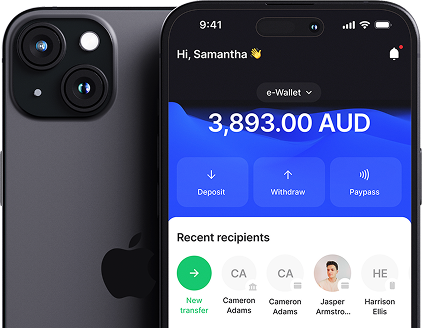Mid-Market Exchange Rate
17 February 2025

Generally speaking, to make the most of your remittances, it can be a good idea to transfer money overseas at a rate as close to the mid-market rate as possible.
It is possible that in the very near future, AI will be able to predict mid-market exchange rates with a strong degree of accuracy.
Also known as the interbank rate or interbank exchange rate, the mid-market rate is the exchange rate big banks use when exchanging currencies amongst one another. Knowing the mid-market rate helps you assess just how much extra money is taken from you when you send money overseas.
In this blog, we will help you understand why mid-market exchange rates matter, direct you where to find them, explain how they work and discuss some of the factors that affect them.
Use e-Pocket to send money overseas at best exchange rates. Unlike many remittance companies and banks, e-Pocket don’t hide fees from you, so you’ll know exactly what excellent deal you’re getting before you send your money overseas.
Why does the mid-market exchange rate matter?
Usually, a mid-market rate is the most genuine rate you will see on any exchange. But this is not true all the time. It constitutes something we might tentatively label the ‘real rate’. This is because it is naturally set by the market, rather than an arbitrary decision made by diktat or bureaucracy. But keep in mind, different data sets use slightly different metrics, which will sometimes marginally affect their final mid-market rate calculation. This means the mid-market rate at any given time is not a definitive or exact number, but it is very close.
How do I find the mid-market exchange rate?
To find a close approximation of the mid-market exchange rate between two currencies, you need only do a quick Google search. This is very valuable, because armed with this information, you will have a better idea of what constitutes a good rate and whether you are being ripped off. It is very common for banks to offer you different rates than those they are operating at.
If you were thinking about sending money overseas with a bank and then found their exchange rate was significantly worse than the mid-market rate – which is likely – you would be able to recognise this fact. For better exchange rates than banks, you should use a company like e-Pocket. Other remittance companies hide extra costs in their own arbitrarily decided exchange rates.
All of this highlights the utility of shopping around for the best exchange rates and to find yourself the best deal possible on any given currency pair.
What does “currency pair” mean?
Take any two different currencies in the world and you have a currency pair. More specifically, Investopedia describes the concept as “the quotation of two different currencies, with the value of one currency being quoted against the other”. Every currency pair in the world has a mid-market exchange rate. For example, if you wanted to send money from Australia to France with e-Pocket, the currency pair would be AUD and EUR. The amount you send would be in AUD, the money your recipient gets would be EUR, and the amount would be decided by the exchange rate between the currency pair.
Predicting changes in the mid-market exchange rate
Principally, the mid-market works on a supply and demand basis. As such, it is actually possible to understand trends in mid-market fluctuations, at least to some extent, by understanding which factors influence the outcome. One example would be the economic conditions of the given country. But understanding a country’s economic health can be complicated. Factors like interest rates, inflation, market dynamics and GDP growth all impact economic situations. We might make the very broad analysis that when the socio-economic situation is trending favourably in a country, the mid-market exchange rate is likely to trend favourably in that country as well.
How is the mid-market exchange rate used
The finance industry uses the mid-market rate for far more than simply sending money overseas. For example, they help decide the prices of goods and services, or the value of assets in foreign currencies. Additionally, it impacts foreign direct investments, as well as international portfolio management. It even governs contract negotiations between international partners to some extent.
What is meant by “bid-ask spread”?
The bid-ask spread, known more commonly as the buy-sell spread, “is the difference between the highest price that a buyer is willing to pay for an asset and the lowest price that a seller is willing to accept”, according to Investopedia. In such situations, those looking to sell receive the bid price, and those buying pay the asking price. Investopedia further explains that “When faced with a standard bid and ask price for a currency, the higher price is what you would pay to buy the currency, while the lower price is what you would receive if you were to sell the currency.” In this situation, the term “bid price” refers to what someone is willing to pay for a currency, and “asking price” refers to the rate that someone will sell the same currency.
Online trading has significantly affected the mid-market rates. Bid-ask spreads are now much tighter than they used to be, as generally bids and offers are much closer to each other than they once were. Middle rate transactions are much less common than they used to be, as less and less transactions are happening via brokers.
Conclusion
Ultimately, mid-market exchange rates are difficult to understand in their totality because so many moving parts affect them. Nonetheless, knowing a little about what they are and how they work can help you to understand what a good deal looks like when sending money overseas from Australia.
We have published a number of different blogs that help our customers understand the various implications of sending money overseas from Australia. You can learn all about the Special Considerations for Sending Money to different countries from Australia, Australia’s international money transfer regulations, anti-money laundering, what exchange rate is and how it is calculated, as well as cash remittance.
Alternatively, you can learn more about the 100+ countries on the e-Pocket blog page.




